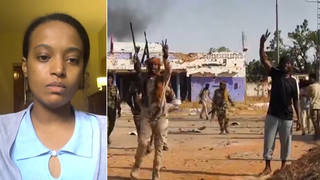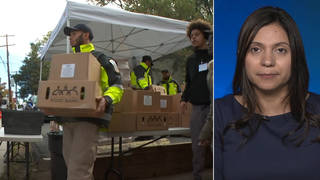
Today on Democracy Now!, we are going to look at an explosive story that has gotten almost no attention in this country. Three weeks ago, on May 8, a U.S. Air Force A-10 Warthog bomber dropped six 500-pound bombs on the village of Maehyang-ri in South Korea. Villagers there claim that seven people were injured and some 170 houses damaged by the bombs. Military officials say the A-10 was experiencing engine trouble and dropped the bombs as an emergency measure to reduce its weight. The A-10 is the plane which U.S. forces used to fire off tens of thousands of rounds of depleted uranium bullets in Iraq during the Gulf War and some 31,000 in Kosovo. [includes rush transcript]
A joint investigation into the bombing has been launched by the US and Korean militaries. US military officials there also denied that the US Air Force uses depleted uranium on the range.
The village where this recent bombing took place is near the Koon-ni Range, where the U.S. has performed military exercises since 1955. And it is not the first time this has happened. Villagers say the 5,000-acre range is the cause of numerous deaths and injuries. They say at least nine people have died in accidents linked to the range, including a pregnant woman killed when a practice bomb hit her in 1967 and four children killed the following year when they tinkered with an unexploded bomb. In 1994, they say, roofs caved in and walls cracked in 100 houses when range workers accidentally detonated bombs. Additionally, they say they suffer from constant exhaust fumes, tremors and extreme noise caused by strafing and bombing exercises since the 1950s.
Some 2,000 residents there have filed a lawsuit seeking nearly $20 million in damages from the repeated bombings.
Guests:
- Brian Willson, a former US Air Force Captain in Vietnam during the war. He is now a peace activist and has been to South Korea several times over the past few years. He was there right after this recent bombing of the Maehyang-ri village took place.
- Rev. Kiyul Chung, a Korean American Methodist minister, originally from South Korea. He currently represents the Congress for Korean Reunification. He also was in South Korea shortly after the bombing of the Maehyang-ri village.
Transcript
JUAN GONZALEZ:
Today, we’re going to take a special look at the activities of the US military in various places around the world, both present and past.
AMY GOODMAN:
That’s right, Juan. It is an “explosive” show. In the last segments of the program, we’ll be joined by Sy Hersh, who did the exposé in The New Yorker magazine of the last days of the Persian Gulf War and the days after the ceasefire, asking the question, “Was General McCaffrey responsible for the slaughter of Iraqi civilians and surrendering Iraqi soldiers?” And we’ll get a response from McCaffrey’s office.
But right now, another exposé: today on Democracy Now! we’re going to look at an explosive story that has gotten almost no attention in this country. Three weeks ago, on May 8, a US Air Force A-10 Warthog bomber dropped six 500-pound bombs on the village of Maehyang-ri in South Korea. Villagers there claim that seven people were injured and some 170 houses damaged by the bombs.
Military officials say the A-10 was experiencing engine trouble and dropped the bombs as an emergency measure to reduce its weight. The A-10 is the plane which US forces used to fire off tens of thousands of rounds of depleted uranium bullets both in Iraq during the Gulf War and in Kosovo.
A joint investigation into the bombing has been launched by the US and Korean militaries. US military officials deny that the US Air Force used depleted uranium on the South Korean range. The village where this recent bombing took place is near the Koon-ni Range, where the US has performed military exercises since 1955. And it’s not the first time that this has happened.
Villagers say the 5,000-acre range is the cause of numerous deaths and injuries. They say at least nine people have died in accidents linked to the range, including a pregnant woman killed when a practice bomb hit her in 1967 and four children killed the following year when they tinkered with an unexploded bomb. In ‘94, they say roofs caved in and walls cracked in a hundred houses when range workers accidentally detonated bombs. Additionally, they say they suffer from constant exhaust fumes, tremors and extreme noise caused by strafing and bombing exercises since the 1950s.
And in the last few years, some 2,000 residents have filed a lawsuit seeking nearly $20 million in damages from the repeated bombings.
We’re joined right now by two people who’ve just returned from South Korea and the area where the most recent bombs dropped. Reverend Kiyul Chung is with us, who is a Korean American Methodist minister, originally from South Korea. And Brian Willson joins us, former US Air Force Captain in Vietnam, he is now a peace activist and has been to South Korea several times over the past few years.
We welcome you both to Democracy Now! Brian Willson, can you please explain what happened on May 8?
BRIAN WILLSON:
Well, Hi, Amy. You did describe that this A-10 Warthog dropped six bombs, as it was experiencing problems, which apparently is a fairly normal operating procedure, that you would drop the bombs in order to save the aircraft from possible crashing, as they said. And it was dropped outside the prescribed area at the Koon-ni Range, closer to the Maehyang-ri village, which has had this problem, of course, for almost fifty years
And because there is sentiment in Korea very critical of the US presence — there’s 37,000 troops and ninety-six bases in South Korea — this has stirred up a lot of concern in Korea again, because it’s perceived as a nuisance, at a minimum, by many Koreans to have the US presence there and especially around this historic farming village. By the way, the villagers — this land was taken from the villagers in the early ’50s, and they are allowed to farm some of the land on this Koon-ni Range on Saturdays and Sundays only, but they do have to pay rent for use of the land from the government.
JUAN GONZALEZ:
Now, Brian Willson, we’ve covered extensively the situation on Vieques, and there the civilian population is about maybe six to eight miles from the main target range. What’s the situation like in Koon-ni, in terms of how close civilians are to the practice ranges?
BRIAN WILLSON:
I think about seven-tenths of a mile.
JUAN GONZALEZ:
Seven-tenths of a mile!
KIYUL CHUNG:
Five hundred meter from residential area. This is Kiyul Chung.
JUAN GONZALEZ:
How close again? Could you repeat that?
KIYUL CHUNG:
Five hundred meter. It’s so close, you can see right there. Five hundred meters from the main residential area, where the bombing practice sites.
JUAN GONZALEZ:
And how has the Korean government allowed this to go on for so long, with the civilian population so close to this range?
KIYUL CHUNG:
Brian, do you want me to go ahead?
BRIAN WILLSON:
Sure, go ahead, Kiyul.
KIYUL CHUNG:
OK, I wonder whether American public is aware of the Status of Forces Agreement, so-called SOFA, since 1967 between US and South Korean government, which has given a free hand for all US troops in South Korea.
AMY GOODMAN:
The Status of Forces Agreement.
KIYUL CHUNG:
Exactly, SOFA. The nationwide protests in South Korea have staged to denounce, to call for repeal of this extremely unjust, unfair agreement between US and South Korea. Under the SOFA agreement, more than 100,000 crimes committed by US troops, soldiers, since 1953, but only 0.25% have been brought to justice. And so, US soldiers now call South Korea as “Heaven for Free Crimes.” And this — actually, Maehyang-ri, we call “Korea’s Vieques” story is an ongoing story of, as I have said, more than 100,000 crimes committed by US soldiers since 1953, in addition to 1.2 million now after No Gun Ri massacre was revealed last year by AP. During the Korean War, we call civilian massacre took place, but only now, after fifty years, this whole story is coming out of the dark tunnel. So this SOFA story with the Maehyang-ri, the Koon-ni bombing range controlled by Lockheed Martin, surprisingly not under US air forces. It’s been transferred to Lockheed Martin, one of the three main military-industrial complex in this country is running. And we pay –
AMY GOODMAN:
Lockheed Martin is running the range.
KIYUL CHUNG:
Exactly. And Brian and I went to see that big sign at the gate, says “Lockheed Martin manager,” put a warning sign to Korean people to do — you know, what to do and what not to do in the air in the bombing site.
AMY GOODMAN:
Brian Willson, you’re a former US Air Force captain in Vietnam. What has the US government said about this most recent bombing?
BRIAN WILLSON:
Well, of course, they acknowledge the bombing, and when we were there, we were there actually a week after the bombing. We were there on May 15. Because the bombs were dropped by an A-10 Warthog, which almost — probably exclusively almost and now used in combat with only depleted uranium cannon fire, raised the question as to whether depleted uranium was being used at Koon-ni Range. And we raised the question. We asked the Korean people this, because, of course, we didn’t know. We did know that at Vieques the Navy had denied using depleted uranium and then finally admitted that they had used depleted uranium, despite it being against US law and regulations. It can only be used, apparently, in actual wartime. So the Korean press asked the US-Korean forces and the Korean government whether in fact depleted uranium had been used at Koon-ni, and they said, “Absolutely not.”
And the use of — the word that was being used was “bombs.” We were using the word “weapons,” but the word “bombs” were being used by the Korean press, and of course they said, no, they don’t have any depleted uranium bombs in Korea either. Not only were they not used at the range, but they don’t have them in Korea.
Well, a few days later, while we were still there, they admitted that in February of 1997, because there was so much commotion around the use of depleted uranium weapons on Okinawa, which also was done inadvertently against the law — “inadvertently,” they said, but admitted that it was unlawful. And they moved the depleted uranium to South Korea, which has this extremely unfair SOFA agreement, where they can get away with almost anything. And so, they admitted that they had depleted uranium in Korea. They were not being used at Koon-ni Range, although they admitted that on two occasions in 1997 depleted uranium weapons had been used by mistake, and reassured the Korean people that if handled properly, in storage, there was no concern for public health and safety.
I think that because the Koreans are so upset continually at this presence of the US military that this dropping of these six bombs has kind of provoked fifty years’ worth of rage, and I think the United States government and the Korean government is quite nervous about how this may be provoking a new wave of anti-US protest in Korea.
KIYUL CHUNG:
May I provide a bit of information about the Maehyang-ri bombing site?
AMY GOODMAN:
Yes. Reverend Kiyul Chung.
KIYUL CHUNG:
OK. Every day, about forty bombers participate in the bombing practice, which becomes about 460 times a week from Monday 8:00 a.m. ‘til Friday 11:00 p.m. about an average fourteen hours a day for the last fifty years, about 500 meters from peoples’ residential area. And it is combined with bombing practice from the air and from the bombers’ machine-gun practice, also going on.
What we were told during our stay in Korea — there were twelve people so far killed, not nine. More than thirty-one people have killed themselves, as suicides, with this whole — the last fifty-year-long ongoing — the noise and all the surrounding environmental issues as well.
And we Korean people in Maehyang-ri, Korea’s Vieques, hope to appeal to American public, American people, who are genuinely concerned of peace and justice elsewhere, hope to have them to come to Korea to join them to begin to occupy bombing practice site, as people in Vieques have done in the last year, and that they and people in Korea are committed to carry out with their own bodies to lay their body down on the line of bombing practice, hope to stop bombing practice after fifty years. So I wonder whether your radio station can help let American public know about — it’s another story of Vieques in Korea, so we could have some help.
JUAN GONZALEZ:
Well, Reverend Kiyul Chung, I’d like to ask you also about the health effects. One report coming out of the BBC from May 16 reports that several of the villages there have reported children born seven to eight years ago with birth defects and that they were children of parents who used to collect bombshells and empty cartridges from the shooting range to sell to second-hand dealers. Has there been any investigation by the Korean government of possible health effects to the villages near the bombing range?
KIYUL CHUNG:
About the Korean government, it’s a shame to say it, but the last fifty years in South Korea, the South Korean government has no say on military issues whatsoever under the SOFA agreement between US and South Korea. And so, it’s a shame that only people have come forward to talk about these health, environmental and other issues. But not government has come in behalf of the people. That’s where our government stands in terms of its relations to the United States.
But as Brian briefly mentioned, after fifty years, finally, people come out to voice out what has happened to them, what must be done, what should be done on this particular case in Maehyang-ri . As you said, Brian talked about, during his press conference in Seoul, when we talked about the depleted uranium bomb, that there are cases of the women who were pregnant and have a birth, and the children with defects, birth defects. And that’s where we questioned whether the DU bomb has been used. And whether they have not been used or have been used, people question now.
Since 1997, May, that the — I mean, Mainichi Japanese, the daily newspaper, carried out a story that Kenneth Bacon, the Defense Department spokesperson, admitted that they have transferred all DU bombs from Japan to South Korea, and we do not know how often, how many times, the US forces in South Korea have used them during their bombing practice in South Korea.
AMY GOODMAN:
Reverend Kiyul Chung and Brian Willson, we have to end this discussion right now, as we move on to another quite remarkable story, and this has to do with the slaughter of Iraqi civilians and surrendering soldiers, allegations being made about General Barry McCaffrey at the end of the Persian Gulf War.
But we would like to continue with part two of this story tomorrow, where we’ll continue to talk about what happened with what many are calling the Vieques of Korea, and also talk about massacres you are investigating that took place during the Korean War, with a front-page piece today in the New York Times talking about No Gun Ri and questioning whether one of the US soldiers who claimed responsibility for a massacre of Korean civilians was actually there. We’re going to talk about whether No Gun Ri was just one of many massacres.
But right now, we’re going to have to end the discussion, and we’ll continue tomorrow. We encourage people to write to us by email if they have questions. We’ll have both our guests back on again. Brian Willson, former US Air Force captain in Vietnam, and Reverend Kiyul Chung, a Korean American Methodist minister, originally from South Korea. Both men have just returned from Korea, investigating the US bombing of the town, a village right next to the Koon-ni bombing range, that sounds very similar to Vieques, the bombing of the Maehyang-ri village.












Media Options